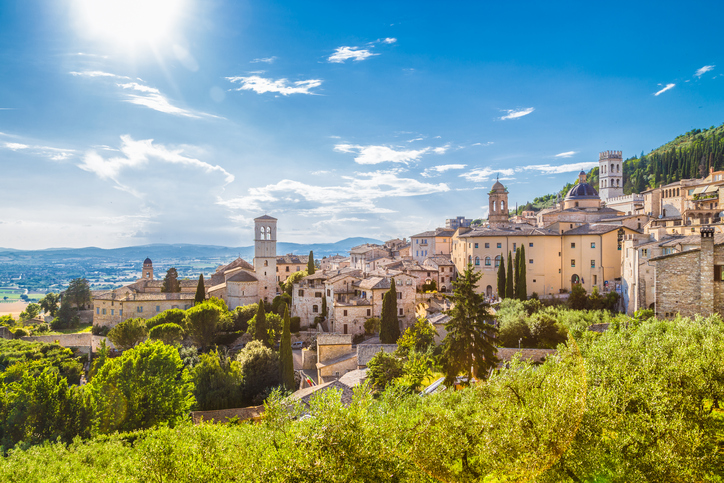
Assisi Italy Attractions
 Located in the rolling hills of central Italy's Umbria region is historic Assisi, birthplace of St. Francis, the patron saint of Italy. Assisi is also the birthplace of St. Clare and Saint Gabriel, making the region a popular religious pilgrimage destination for followers worldwide.
Located in the rolling hills of central Italy's Umbria region is historic Assisi, birthplace of St. Francis, the patron saint of Italy. Assisi is also the birthplace of St. Clare and Saint Gabriel, making the region a popular religious pilgrimage destination for followers worldwide.
This ancient region was first settled around 1000 B.C. by immigrants who came to be known as the Umbrians, the name probably deriving from the Greek Ombrii, translated as "the people of the thunderstorm." It's theorized that these settlers were either survivors of the Great Flood or direct descendants. Bordered by the Tiber and Nar Rivers as well as by the Apennine Mountains, the Umbrians built their early settlements on hilltops, notable for being easily defended from invaders.
Assisi Italy Attractions
Visitors to Assisi are face-to-face with history at every turn, not only by the many sacred religious shrines, but also by well-preserved remnants of the region's centuries-old ethnic and cultural diversity. The Basilica di San Francesco, the Franciscan Order's mother church, is one of Italy's most-visited and revered Christian pilgrimages. Built into the side of a hill, construction was begun in 1228, immediately after St. Francis' canonization. Consisting of two churches (the Upper and Lower), and a crypt containing the remains of St. Francis, the Basilica's interiors contain priceless artworks by late medieval Roman and Tuscan painters which adorn the walls of the Gothic and Romanesque-styled structures. Another of Assisi's more popular attractions is the Eremo della Carceri, the fabled rural retreat where St. Francis often meditated and preached to the birds. The many caves surrounding the region have long served as a hermitage for Franciscan monks, a practice which continues into the 21st-century. According to legend, a young Francis was first inspired to undertake a life devoted to self-sacrifice while worshipping at the Porziuncola, a tiny, ninth-century church that became the Franciscan's most sacred shrine. In the late 16th century, construction began on the Santa Maria degli Angeli, a Basilica which was built around the small church as well as the Cappella del Transito, a small room, where on October 3rd, 1226, St. Francis died. Other features include the Rose Garden and Chapel, and stunning artwork is prominently displayed throughout the Basilica. An encounter between St. Francis and Christ is said to have occurred in 1205 at the San Damiano church, a small, unimposing 12th-century structure near Assisi. Later, it was to become the home to Assisi's Saint Clare, with a convent community eventually constructed around it by her followers. Chiesa Nuova is a church built in 1615 on the presumed site of the remains of St. Francis' birthplace, the di Bernardone family home. Constructed in late Renaissance-style, this high-domed structure features a foundation stone blessed by Pope Paul V and contains several richly-detailed frescoes depicting scenes from St. Francis' extraordinary life.
Other "must-see" attractions in and around Assisi include the Rocca Maggiore, the largest of two medieval castles that provides an intimidating presence from its location high atop a hill overlooking the city. For the more adventurous visitor, a short excursion to nearby Parco del Monte Subasio is a nature-lover's paradise. This natural park atop Mount Subasio is noteworthy for its surrounding pink stones, breath-taking scenic vistas and acres of colorful flowers. The childhood home to Saints Clare and Agnes, Sasso Rosso (or "Redrock"), a castle situated on a mountain slope, is yet another popular tourist destination. Assisi's Roman history and influence is evident in the remains of a Roman amphitheater, estimated to have been built in the first-century AD. Surrounded by medieval-style residences and containing distinctive archways, this remnant today serves as a colorful garden.
